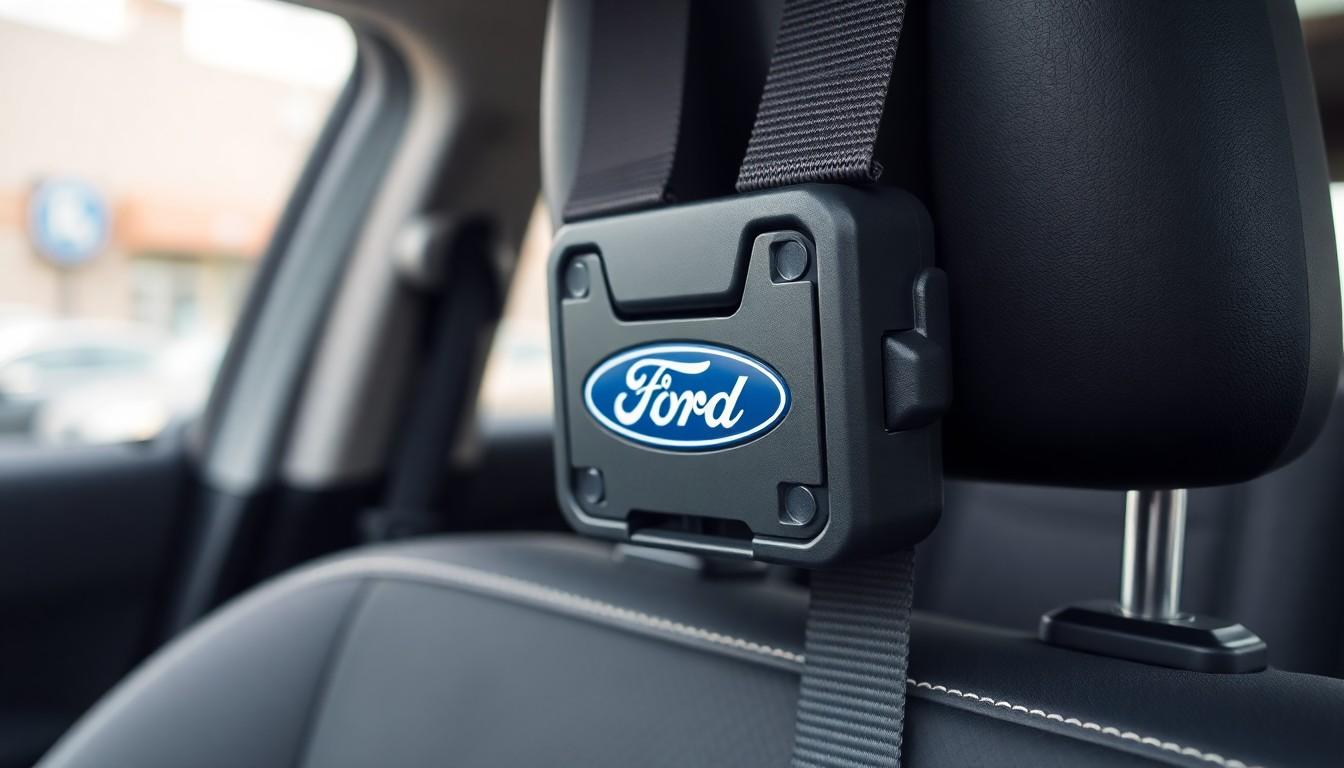Dealing with a rear belt monitor fault in your Ford vehicle can be frustrating and concerning. This warning light typically indicates an issue with your vehicle’s seat belt system, potentially compromising safety features designed to protect you and your passengers.
We’ve helped thousands of Ford owners troubleshoot this common problem, and understand how alarming these dashboard warnings can be. Whether you’re experiencing this issue in your F-150, Explorer, or any other Ford model, the good news is that many rear belt monitor faults can be resolved without expensive dealer visits. In this comprehensive guide, we’ll walk you through the causes, diagnostic steps, and proven answers to get your Ford back to optimal safety performance.
Understanding the Rear Belt Monitor System in Ford Vehicles
Ford’s rear seat belt monitoring system serves as a crucial safety feature that helps protect passengers by alerting drivers when rear seat belts aren’t properly fastened. This advanced technology forms part of Ford’s comprehensive safety suite, introduced to enhance passenger protection and reduce potential injuries during accidents.
The system uses sensors strategically placed throughout the vehicle to detect whether rear seat occupants are properly buckled up. These sensors connect to your vehicle’s main computer system, triggering dashboard alerts when they identify unfastened seat belts. Common alert indicators include a warning light on the instrument panel, chimes, or messages displayed on the information center screen.
Most modern Ford models manufactured after 2015 come equipped with this technology, including popular vehicles like the F-150, Explorer, Escape, and Fusion. Ford designed this feature to comply with safety regulations while providing drivers with real-time information about their passengers’ safety status.
The rear belt monitor works by:
- Detecting the presence of passengers in rear seats through weight sensors
- Monitoring the engagement status of seat belt buckles
- Sending signals to the vehicle’s Body Control Module (BCM)
- Displaying appropriate warnings when safety requirements aren’t met
Understanding how this system functions helps diagnose potential issues when fault warnings appear. The monitor continuously checks seat belt status and communicates with multiple vehicle systems, making it susceptible to various electronic and mechanical failures that can trigger warning messages.
Common Symptoms of a Rear Belt Monitor Fault

Ford owners experiencing a rear belt monitor fault typically encounter exact warning signs that indicate issues with the seat belt monitoring system. These symptoms often appear consistently and require attention to ensure proper safety system functionality.
Warning Light Indicators
Dashboard display warnings constitute the primary visual alert when a rear belt monitor fault occurs. The most common indication is a exact message reading “rear belt monitor fault” or “rear belt monitor fault – service required” prominently displayed on your instrument panel. This warning message usually requires manually pressing an “OK” button to dismiss temporarily, though it frequently reappears shortly afterward, indicating an ongoing issue rather than a one-time glitch. A yellow airbag warning light often accompanies this fault message, further signaling potential problems with the seat belt monitoring system. These visual alerts persist until the underlying issue is addressed, with only temporary relief after acknowledgment.
Audible Alert Issues
While the primary notification method for rear belt monitor faults is visual, your Ford may produce accompanying audio signals to draw attention to the problem. Though exact audible alerts aren’t extensively documented for this particular fault, Ford vehicles typically emit a beep or chime when dashboard warning messages appear. In some instances, the fault affects additional vehicle systems, such as automatically disengaging cruise control when a driver’s seat belt monitor fault is detected. The underlying cause often relates to problems with the rear seat belt buckles themselves or loose/faulty connectors in the seat belt wiring system. Checking or replacing these components resolves the fault in many cases, restoring proper functionality to your vehicle’s safety monitoring systems.
Causes of Rear Belt Monitor Failures in Ford Models

The “Rear Belt Monitor Fault” warning in Ford vehicles stems from several key issues within the safety monitoring system. Understanding these common causes helps Ford owners troubleshoot the problem effectively before seeking professional assistance.
Seat Belt Buckle Issues
Faulty seat belt buckles represent the most frequent cause of rear belt monitor failures in Ford models. Both rear passenger and driver’s seat buckles can trigger this warning when they malfunction. The internal mechanisms within these buckles contain sensors that communicate with the vehicle’s safety system, and when they fail, the system registers an error. Replacing the defective buckle typically resolves the issue completely, restoring proper functionality to the monitoring system.
Electrical Connection Problems
Electrical connection failures frequently trigger the rear belt monitor fault in Ford vehicles. These problems commonly occur when rear seats are removed for cleaning or modification without properly reconnecting the seat belt plugs. Damaged wiring harnesses or loose connectors can interrupt the signal between the seat belt sensors and the vehicle’s Body Control Module. Inspecting all seat belt connectors for secure connections and signs of physical damage often provides a quick fix for this issue.
Sensor Malfunctions
Seat belt monitoring systems rely on sophisticated sensors that detect whether belts are fastened correctly. These sensors can deteriorate over time or experience electronic failures that trigger fault warnings. Ford models sometimes exhibit false readings when sensors in the buckles become contaminated with debris or moisture. The driver’s seat buckle sensor occasionally causes system-wide alerts that mistakenly appear as rear belt issues. Diagnosing sensor problems typically requires testing each component individually to identify the exact malfunctioning unit.
Other Potential Causes
Several additional factors can contribute to rear belt monitor faults in Ford vehicles. Recent software or system updates sometimes create compatibility issues within the safety monitoring network. Physical obstructions preventing seat belts from locking properly might trick sensors into detecting an error condition. Ensuring rear seatbelts remain properly secured when not in use helps prevent unnecessary warnings. BCM (Body Control Module) programming errors occasionally require professional diagnostic equipment to resolve persistent fault messages.
Diagnosing a Rear Belt Monitor Fault in Your Ford

Diagnosing a rear belt monitor fault in your Ford vehicle requires a systematic approach to identify the root cause. We’ve compiled effective methods to help you troubleshoot this common safety system issue before heading to the dealership.
Using OBD Scanners
OBD scanners provide valuable diagnostic information when troubleshooting rear belt monitor faults. These tools can help identify general fault codes, though they may not always pinpoint the exact seat belt system issue directly. Standard OBD scanners access basic vehicle information, but for more detailed analysis, Ford-exact diagnostic tools like ForScan offer comprehensive insights into the seat belt monitoring system’s functionality. ForScan can reveal exact fault codes related to the seat belt sensors and connections that generic scanners might miss. Professional diagnosis at a Ford dealership remains beneficial for persistent issues, as dealers have access to advanced diagnostic equipment designed specifically for identifying seat belt monitoring system problems.
Visual Inspection Methods
Visual inspection serves as the first line of diagnosis for rear belt monitor faults in Ford vehicles. Start by checking if all rear seat belts are properly buckled and locked securely in place—improperly secured belts frequently trigger warning messages. Examine the seat belt buckles carefully, looking for physical damage or debris that might interfere with the sensor contacts. The fault commonly originates from defective buckles, including both rear seat and driver’s seat buckles. Inspect all electrical connectors associated with the rear seat belts, especially if seats have been previously removed or adjusted. Even with seats removed, disconnected wiring can trigger fault messages in the monitoring system. Reconnecting loose wiring or replacing damaged buckles often resolves the issue without requiring dealer intervention.
How to Fix Rear Belt Monitor Faults

Resolving rear belt monitor faults in Ford vehicles is often achievable through straightforward repairs. Most issues relate to malfunctioning seat belt buckles or incorrect connections that trigger the system warnings.
DIY Repair Options
Replacing faulty seat belt buckles offers the most effective solution for rear belt monitor faults. Many Ford owners report successfully eliminating the warning by installing a new driver’s seat belt buckle or rear seat buckles. Checking all seat belt connectors ensures they’re properly plugged in, especially if you’ve previously removed or modified rear seats. Disconnected or improperly seated electrical connections commonly trigger these fault messages.
Temporary relief might come from simply buckling all rear seatbelts and acknowledging the warning on your dashboard. This method, while not a permanent fix, can temporarily clear the alert until you carry out a more lasting solution. Remember to inspect each buckle for visible damage, debris, or signs of malfunction before replacing components.
When to Seek Professional Help
Professional assistance becomes necessary when DIY answers don’t resolve persistent rear belt monitor faults. Ford dealerships or certified mechanics possess specialized diagnostic equipment to identify complex issues within the seat belt monitoring system. Vehicles exhibiting recurring faults after buckle replacement likely have deeper electrical or module-related problems requiring expert attention.
Diagnostic tools like Forscan allow technicians to access the Restraint Control Module (RCM) for exact error codes. These specialized tools provide detailed information unavailable through basic inspection methods. Parts availability also influences repair approaches – if required components like exact seat belt buckles are on national backorder, dealership service departments can better navigate the procurement process.
Software-related issues sometimes emerge after vehicle updates, potentially requiring dealer re-diagnosis to address underlying system incompatibilities. Ford owners who’ve made physical modifications to their vehicles should consult professionals to ensure all electrical connections related to the safety systems remain properly integrated to prevent recurring fault messages.
Cost Implications of Rear Belt Monitor Repairs

Fixing a rear belt monitor fault in Ford vehicles ranges from affordable DIY answers to more expensive professional repairs. The final cost depends largely on the exact issue causing the fault and your chosen repair approach.
DIY and Basic Repairs
Basic repairs often present the most economical option for Ford owners. Replacing a faulty seatbelt buckle typically costs around $30 for the part itself, making it an affordable fix if you’re comfortable with simple vehicle maintenance. Minor electrical problems like loose wire connections might cost even less if you already own basic tools and have some technical knowledge.
Professional Repair Services
Specialized repair services offer a middle-ground option for more complex issues. Companies like Safety Restore provide dedicated seat belt repair services for Ford vehicles at fixed rates between $65-$79.99. These services handle exact problems such as locked or blown retractors without requiring complete replacement of the entire system.
Diagnostic Tools
Accurate diagnosis forms an essential part of addressing rear belt monitor faults efficiently. An OBD scanner helps identify the exact nature of the problem, with basic models available from $20 while advanced scanners with enhanced capabilities cost $100 or more. This investment often pays for itself by preventing unnecessary repairs and pinpointing the exact issue.
Comprehensive Repairs
Complex problems involving the vehicle’s airbag system or integrated safety features generally incur higher costs. These situations typically require professional intervention from a Ford dealership or certified mechanic. Labor charges combined with replacement of major components can significantly increase the total repair expense, potentially reaching several hundred dollars for comprehensive answers.
Ford Models Most Affected by Rear Belt Monitor Issues

The Ford Maverick lineup, particularly 2022 and newer models, frequently experiences rear belt monitor faults. These issues often stem from problematic seat belt buckles or system malfunctions in the rear seat monitoring components. Many Maverick owners report dashboard warnings even though all belts being properly fastened.
Ford Bronco Sport vehicles, especially the 2021 Outer Banks trim, commonly display this error message. Interestingly, some Bronco Sport owners discovered the fault originated from the driver’s seat belt buckle rather than the rear belts indicated by the warning. This suggests potential communication issues within the vehicle’s safety monitoring network.
Various Ford truck models across different production years share susceptibility to rear belt monitor faults. The problem transcends exact models, indicating a broader issue with Ford’s implementation of safety monitoring systems in their truck lineup. Forum discussions reveal similar experiences among owners of different Ford truck variants.
Several consistent causes appear across affected Ford models:
- Malfunctioning sensors within the seat belt assembly
- Damaged or loose wiring connections
- Faulty control modules requiring recalibration
- Mechanical failures in the seat belt buckle components
The prevalence of these issues across multiple Ford models suggests a potential pattern in component sourcing or system design that creates vulnerability to monitoring faults. Identifying your exact Ford model helps in narrowing down the most likely cause and appropriate repair approach.
Conclusion
Addressing rear belt monitor faults in your Ford vehicle doesn’t have to be intimidating or expensive. With proper diagnosis using OBD scanners or visual inspection techniques we’ve outlined you can often identify the issue yourself.
Whether it’s a simple fix like replacing a seat belt buckle or reconnecting loose wiring most problems can be resolved without dealer intervention. For more complex issues involving the RCM or system programming professional help may be necessary.
Remember that your vehicle’s safety systems are designed to protect you and your passengers. Taking care of these alerts promptly ensures your Ford continues to provide the protection you expect. By understanding the common causes and answers exact to your model you’ll save time money and maintain your vehicle’s critical safety features.
Frequently Asked Questions
What is a rear belt monitor fault in Ford vehicles?
A rear belt monitor fault is a warning that appears in Ford vehicles when the system that monitors rear seat belt usage detects a problem. This safety feature, present in most Ford models manufactured after 2015, is designed to alert drivers when rear seat belts aren’t properly fastened. When malfunctioning, it typically displays a dashboard warning message and may be accompanied by a yellow airbag warning light.
What causes rear belt monitor faults in Ford vehicles?
The most common causes include faulty seat belt buckles with malfunctioning sensors, electrical connection problems (often after seat removal), sensor contamination or deterioration, software compatibility issues, physical obstructions affecting seat belt locking, and Body Control Module (BCM) programming errors. The issue is frequently related to problems in the buckles or wiring connectors of the safety monitoring system.
How can I diagnose a rear belt monitor fault myself?
Start with a visual inspection of rear seat belts to ensure they’re properly buckled. Check buckles and electrical connectors for visible damage or debris. For deeper diagnosis, use an OBD scanner, preferably Ford-specific tools like ForScan, to retrieve error codes related to the seat belt monitoring system. This systematic approach helps identify the root cause before attempting repairs.
Can I fix a rear belt monitor fault without going to a dealer?
Yes, many rear belt monitor faults can be resolved without a dealer visit. Common DIY repairs include replacing malfunctioning seat belt buckles and ensuring connectors are properly seated. A temporary fix involves buckling all rear seatbelts, though this isn’t a permanent solution. Basic repairs are often straightforward and can be completed with minimal tools.
When should I seek professional help for a rear belt monitor fault?
Seek professional help if DIY solutions don’t resolve the issue, if the fault is accompanied by multiple warning lights, or if you suspect complex wiring or software problems. Professionals have specialized diagnostic equipment to access the Restraint Control Module (RCM) for precise error codes and can address issues that arise after vehicle updates or those involving integrated safety systems.
How much does it cost to fix a rear belt monitor fault?
Repair costs vary widely based on the issue. DIY repairs like replacing a faulty seatbelt buckle cost around $30 for parts. Specialized repair services charge fixed rates between $65-$80. Comprehensive repairs involving the airbag system or integrated safety features typically cost several hundred dollars and require professional intervention. Accurate diagnosis is crucial to avoid unnecessary expenses.
Which Ford models are most affected by rear belt monitor issues?
The 2022+ Ford Maverick and 2021 Bronco Sport are particularly prone to these issues, often due to problematic seat belt buckles or system malfunctions. Various Ford truck models also frequently experience these faults. Common causes across affected models include malfunctioning sensors, damaged wiring, faulty control modules, and mechanical failures in seat belt components.
Is it safe to drive with a rear belt monitor fault warning?
While you can technically drive with this warning, it indicates a compromised safety system. The vehicle’s ability to monitor rear passenger safety is impaired, which could be critical in an accident. It’s advisable to address the issue promptly, especially if you regularly transport passengers in rear seats. In the interim, ensure all passengers manually buckle up.

